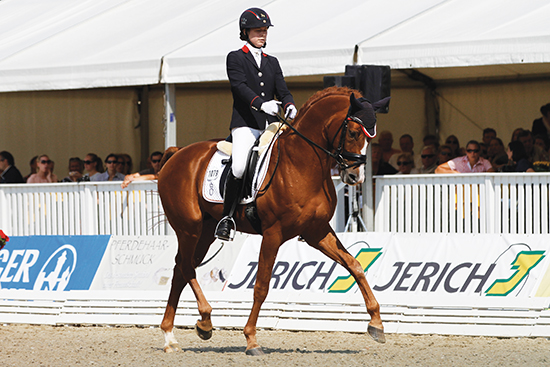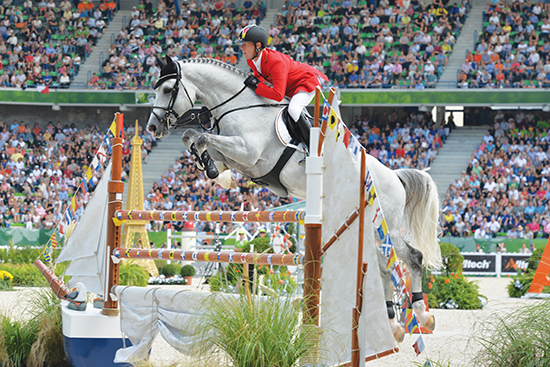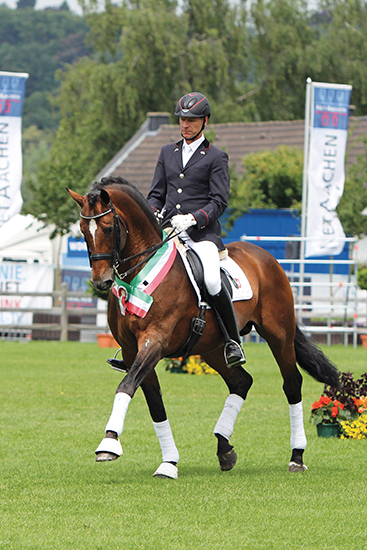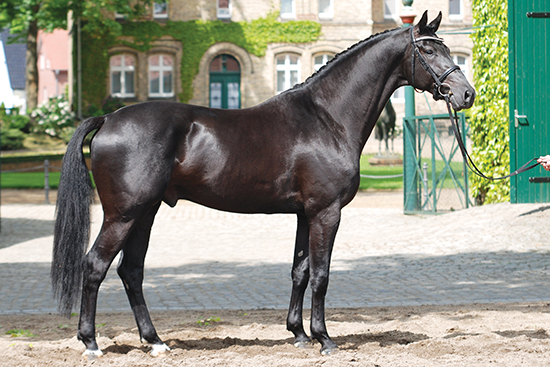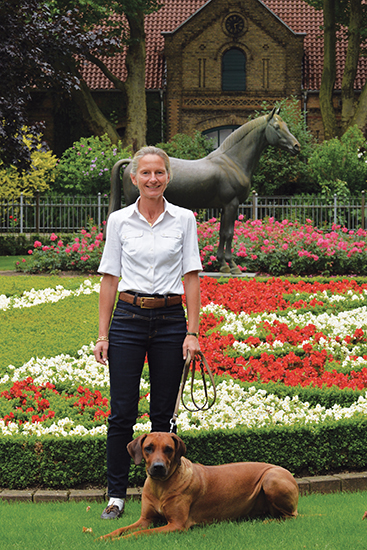 Story by Christopher Hector
Story by Christopher Hector
It is always a joy to catch up with the director of the Westfalen State Stud at Warendorf, if for no other reason than it provides an excuse to walk through this most beautiful of studs, with its historic buildings and imposing trees.
In fact, we are strolling in the direction of the director’s office when we come across the director herself, and one of her assistants, and it looks very much as if they are in the process of selling a horse to a couple of visitors to the stud. Susanne is very much the hands-on director, a contrast to the lofty god-like gentlemen who headed up the state studs before she became the first woman director… now with the appointment of 32-year-old Dr Carina Krumbiegel to the position at Baden-Würtemberg, along with Dr Astrid von Velsen-Zereweck at Marbach, there are three women directors in the German State Stud system… and state stallions compete!
Susanne has just finished judging a round of foal shows, and is aglow with enthusiasm for the progeny of the new dressage star she has discovered.
“The foals that have made our commission most enthusiastic, have been the foals of Sir Heinrich, a son of Sir Donnerhall from a Fürst Heinrich mother. Sir Heinrich is six years old now, and he has really really exciting foals, out of different mares. The gaits, walk, trot and canter, everything… conformation. The stallion himself is quite a small, tiny stallion, and when I bought him, the breeding commission at the licensing said, ‘oh what do you want with this pony?’ But they gave him the chance. He won the performance test, second from all over Germany, then he was vice champion at the Bundeschampionate at the age of five, and went on to the world championship. This year, he also qualified for the six-year-old championship at the Bundeschampionate, and he is the first reserve for the World Championship.”
Sir Heinrich and Anja Wilimzig, winners of the 2014 Bundeschampionate.
Photo: Kenneth Braddick
(Since then, Sir Heinrich went to the 2014 Bundeschampionate and was the Six Year Old Champion…)
“I found him at the stable of Heinrich Ramsbrock. The breeder is Paul Wendeln, I think many people know him – he is a well known breeder in Oldenburg. The mother family was the winner of the German championship of breeding mares, some years ago, and it is a really good mother line. Paul Wendeln did not prepare the stallion for the licensing because he was so tiny, and Heinrich Ramsbrock saw this colt and he fell in love with him. When we came to his place to select stallions for our stud, Sir Heinrich had been there just one day. After we’d seen a lot of stallions, he said, ‘oh I have another one, I will show you’ and Sir Heinrich came in and immediately we were taken with this horse. He was cantering, he was trotting, he stood there, and we said ‘we want to buy this stallion. And at once!”
“Mr Ramsbrock was so happy that there was another person who would fall in love with this horse – he’s a very emotional person, so we could buy him for a very good price.”
And he’s crossing well over a lot of different mares…
“This is really interesting. You know in former times, when we had breeders who might have been beginners, and they didn’t know much about their mares, we could always say ‘use Florestan’, because Florestan is very safe and produced really a high percentage of foals that were similar to Florestan. Now unfortunately Florestan is dead – okay he had a good long life – and Sir Heinrich may step into his hooves, because we again can tell the breeder, if you use this stallion for your mare, you have a very sure prediction that the foal will be in this or that conformation…”
And not small?
“No, not small. The first thing the breeders noticed when the foals were born, was, wow, they are not small!”
Cornado NRW, competed a the WEG with Marcus Ehning
With the jumpers, which stallions are impressive?
“The champion for us is Cornado NRW, who is very successfully competing at an international level with Marcus Ehning. This is also very good – he is not just a good sporthorse, he is a good sire. His foals are very elastic, very good types. He himself is a very nice type – and they are very sportif foals. Of course he is one of my favorites, but of course he does not have so many foals because he is so busy competing that we don’t have that much semen. We have many breeders who want to use him, or they used frozen semen this year – from France, from Belgium, where he was competing very successfully.”
“With the younger stallions, there is one very interesting stallion, Cup Cooper, a son of Cooper van de Heffinck, then Clinton/Ramiro. He is a five-year-old Belgian stallion and he has very very typey foals with very good muscles, they are so strong, and when they canter they have such presence. He doesn’t have many foals because he is a young stallion, and at the moment it is very difficult to get mares for young stallions. I saw about 20 foals this year from this young stallion, they are all in one shape – you can see immediately, ‘oh it’s a Cup Cooper’. Really good foals – and he is also competing really well.”
Has that been one of the most successful things you have done as the Director – you got the jumping stallions out competing…
“It belongs to my time here at the stud, and I think it is a very important development. Today, we couldn’t manage stallions without competing – all our young stallions, dressage and jumping, are in competition. They start usually at the age of four, and then it goes until they are too old for sport, or are not used by the breeders any more. When I started it was a really imported goal for me, that all stallions had a chance to compete. It meant getting riders here who are able to compete and to train and educate the stallions. I have been quite lucky with this.”
Quite lucky, or someone with the foresight to see what needed to happen…
“Both I hope,” Susanne laughs. “But I am sitting on a horse every day still. Usually I ride one, two stallions. At the moment I am riding a three-year-old, but usually I ride the older ones, and this is very important. To keep the feeling for riding – so when I watch a foal, or a two-year-old stallion, I try to feel how it is to ride him, even with a foal when it starts to move. There are gaits that might be spectacular, but when I think about riding them, I think oh my god! For me it is important to keep this connection between riding and breeding.”
Laureus – Warendorf’s most succesful dressage stallion has just been retired from competition. Photo: Stephanie Borggreve
Which is your favorite stallion?
“This is very difficult to say… it may depend on quality, or on the personal contact. If we are talking about personal contact, I will say Laureus, the son of Laurentianer. In one of our previous interviews, we made a story about Laurentianer, and now Laureus is his first licensed son, who went on to win the licensing. This was a great success for me because Laurentianer was one of the first stallions I bought, and to have his first son a winner…. Laureus has a very good character, he is our most successful dressage horse, with more than 45 dressage placings. But he is also a great character, for me he is a friend, this is a really close connection I have to this horse. There may be others with higher quality but this one is my personal favorite.”
On a more depressing note, I have been talking to many people in many breeding areas across Europe and they are all talking about the down-turn in breeding, with up to 50% less mares being bred…
“It is really difficult. Last year, fortunately, we didn’t lose any, so we had the same number as the year before. But we had one stallion, All At Once – this is typical for our times – a three year old, and last year he covered more than 400 mares! He saved our numbers, this year he has about 150/160, still a lot, but not that high any longer.”
All At Once – by Ampère, out of a Gribaldi / Jazz / Contango mare… 400 mares!
Photo: Stephanie Borggreve
Does that make you uncomfortable, with a young stallion covering so many mares?
“Yes, because you don’t know anything about the stallion, you don’t know which mare bloodline. He is black and very pretty, his father is Ampère and his mother, Gribaldi, and since Totilas, with Gribaldi, everything is good. There is no stallion that fits with all bloodlines, and the danger is that a stallion covers a lot of mares that don’t fit with him. It’s not good for the breeder, of course, when he doesn’t have a good foal, and for the stallion, it’s not good because when he covers many mares, there are also many not-so-good foals, and these are the foals the people talk about.”
“The older stallions, where you have really good information, nobody wants – I can’t understand this, it just doesn’t make sense. The breeders think ‘oh, the first year, and the black stallion, I want to be one of the first with a foal’, but there are more than 300 foals, and if you have one not-so-good, then it is nearly impossible to sell it. But we can’t stop it, we can’t say no, we need the mares and we need the money. This is a leased stallion, I can’t go to the owner and say, oh I told these mare owners that they should not use your stallion. I am not comfortable with this, but I can’t help the breeders, when they don’t want to know, we have to accept it. Maybe it will change when lots of breeders have learnt from their experience.”
This article first appeared in the November 2014 issue of THM.

